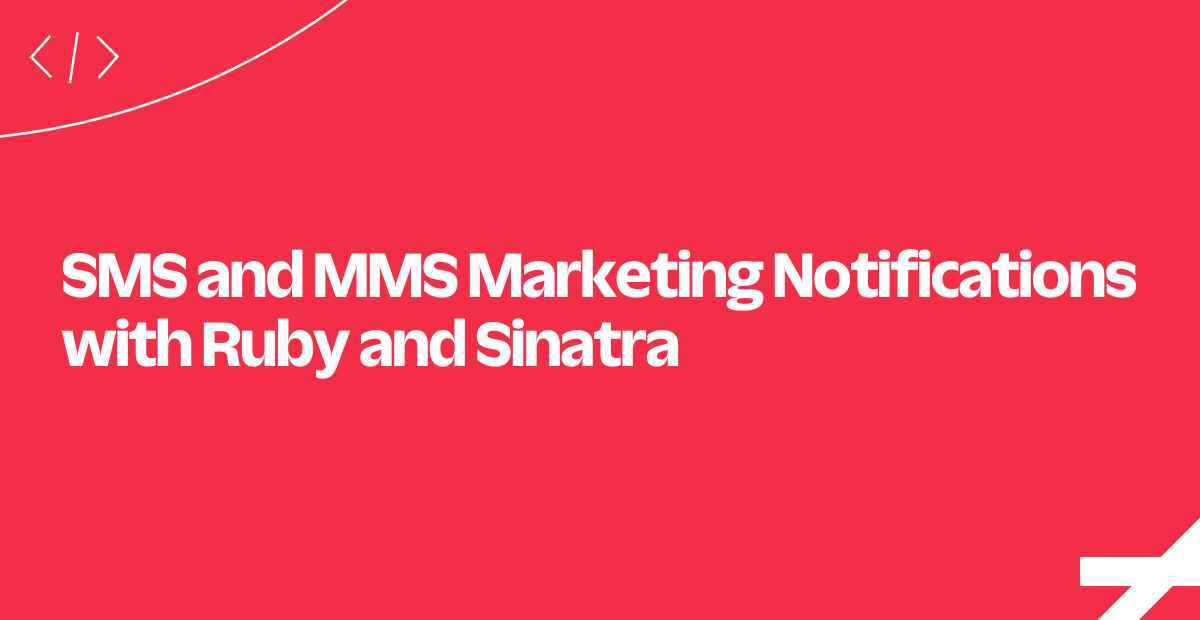SMS and MMS Marketing Notifications with Ruby and Sinatra
Time to read: 3 minutes

Ready to implement SMS and MMS marketing notifications in your Ruby and Sinatra application?
Here's how it will work at a high level:
- A possible customer sends an SMS to a Twilio phone number you advertise somewhere.
- Your application confirms that the user wants to receive SMS and MMS notifications from your company.
- An administrator or marketing campaign manager uses a web form to craft a message that will go out to all subscribers via SMS/MMS message.
Building Blocks
To get this done, you'll be working with the following tools:
- TwiML and the <Message> Verb: We'll use TwiML to manage interactions initiated by the user via SMS.
- Messages Resource: We will use the REST API to broadcast messages out to all subscribers.
- Sinatra Framework: We'll use Sinatra to structure the application.
- DataMapper: We'll use DataMapper to define the model and to persist it.
Let's get started!
The Subscriber Model
In order to send out marketing notifications to a subscriber, we need to provide the right model.
phone_numberwill store where to send the notifications.subscribedlets the application identify which subscribers are active (only an active subscriber will receive notifications).
Next up, let's see how to handle incoming messages.
Handle Incoming messages
This is the endpoint that will be called every time our application receives a message.
It checks if the command sent in the message is one of the commands that we are expecting. Depending on that it returns a message formatted in TwiML - either a confirmation or a helpful message with our legal commands.
Let's see how to create new subscribers next.
Create New Subscribers
On an incoming message, we look in the database for a matching number. If there isn't one, we create a new Subscriber. If it does, we validate the command from the message body and send an appropriate TwiML response.
And that's all we want at this step! We've created a Subscriber model to keep track of the people that have requested our messages. We also have saved their information on the database after receiving a text message with an 'add' command.
Now let's look at how our users can manage their subscriptions.
Managing Subscriptions
We want to provide our users with two SMS commands to manage their subscription status: add and remove.
These commands will toggle a boolean flag for a Subscriber record in the database and will determine whether or not our user will receive messages from our marketing campaign. We don't opt them in automatically - rather, we have them confirm that they want to receive our messages.
To make this happen, we will need to update the controller logic which handles the incoming text message to do a couple things:
- If it is an
addcommand orremovecommand, then create/update her or his subscription with the right status in the database. - If it is a command we don't recognize, then send a message explaining our available commands.
Next up, let's look at how to send notifications.
Sending Notifications
When we receive a form submission from the frontend, we first grab the message text and optional image URL. Second, we loop through all Subscribers and call the send_message method to send the message out.
When the messages are on their way, we render back the index page with a success message (and make the marketing team happy).
Let's take an even closer look at how to send SMS or MMS notifications.
Send SMS or MMS Notifications
In the method send_message we create a Twilio REST API client that can be used to send SMS and MMS messages. The client requires your Twilio account credentials (an account SID and auth token), which can be found in the console:

Next all we need to do is call create on the client.messages object in order to send our message. The Twilio Message API call requires a from, to and body parameter. The media_url is optional.
That's it! We've just implemented an opt-in process and an administrative interface to run an SMS and MMS marketing campaign.
Next let's look at what other features you might like to deploy.
Where to Next?
Twilio and Ruby mix incredibly well. To prove it, here are two excellent tutorials on how to add other features:
Add an interface to your employee directory to look up contact information through your phone.
Follow along with this simple tutorial to see the code necessary to implement automated surveys that integrate directly with your CRM and customer database.
Did this help?
Thanks for checking out this tutorial! Tweet @twilio to let us know what you think!
Related Posts
Related Resources
Twilio Docs
From APIs to SDKs to sample apps
API reference documentation, SDKs, helper libraries, quickstarts, and tutorials for your language and platform.
Resource Center
The latest ebooks, industry reports, and webinars
Learn from customer engagement experts to improve your own communication.
Ahoy
Twilio's developer community hub
Best practices, code samples, and inspiration to build communications and digital engagement experiences.


